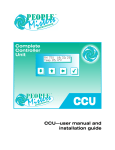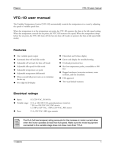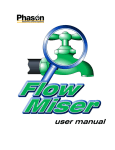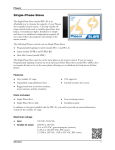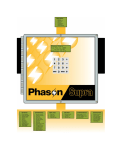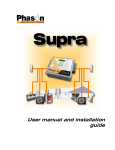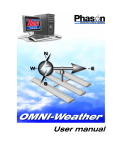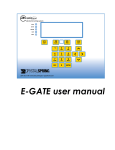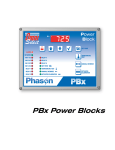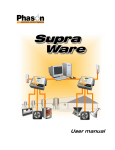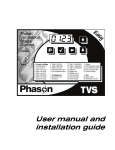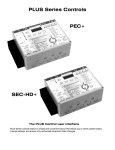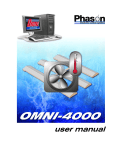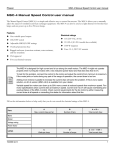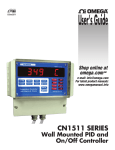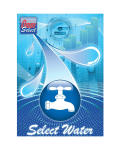Download PLC user manual
Transcript
ECC-1—user manual and installation guide Table of contents Introducing the ECC-1 .....................................................................................................................1 Features ....................................................................................................................................................2 Electrical ratings........................................................................................................................................2 Optional accessories ................................................................................................................................3 About this manual .....................................................................................................................................3 Using the buttons......................................................................................................................................4 About the status LEDs...............................................................................................................................4 Using the menu system ............................................................................................................................5 Understanding evaporative cooling..........................................................................................................5 Understanding cooling cycles ..................................................................................................................6 Installing the ECC-1 .........................................................................................................................8 ECC-1 layout .............................................................................................................................................9 Warnings and installation notes..............................................................................................................10 Mounting the ECC-1................................................................................................................................11 Connecting equipment to the terminals..................................................................................................11 Connecting pumps .............................................................................................................................12 Connecting sprinkler solenoids ..........................................................................................................12 Connecting fans..................................................................................................................................13 Connecting temperature probes ........................................................................................................14 Connecting humidity sensors .............................................................................................................16 Connecting the alarm relay to an alarm circuit...................................................................................16 Connecting the incoming power ........................................................................................................17 Finishing the installation..........................................................................................................................18 Configuring the ECC-1 ..................................................................................................................19 Selecting the input frequency .................................................................................................................19 Setting the date and time........................................................................................................................20 Selecting the temperature units ..............................................................................................................22 Selecting the control mode.....................................................................................................................22 Configuring relays ...................................................................................................................................24 Programming the ECC-1 ...............................................................................................................25 Programming sprinkler relays.................................................................................................................25 Programming sprinkler relays for soaking..........................................................................................25 Programming sprinkler relays for misting/fogging .............................................................................28 Programming pump relays .....................................................................................................................31 Programming fan relays..........................................................................................................................32 Programming the humidity bypass.........................................................................................................33 Programming alarms ..............................................................................................................................34 How alarm settings work ....................................................................................................................35 Programming the active time ..................................................................................................................36 i Using and maintaining the ECC-1.................................................................................................38 Acknowledging alarms........................................................................................................................... 38 Using Manual Control Mode .................................................................................................................. 39 Selecting display options ....................................................................................................................... 40 Displaying the firmware version ............................................................................................................. 41 Resetting the cycle................................................................................................................................. 42 Loading the factory defaults................................................................................................................... 43 Maintaining the ECC-1 ........................................................................................................................... 43 Cleaning the ECC-1 ........................................................................................................................... 44 Appendices ....................................................................................................................................45 Appendix A: Worksheets........................................................................................................................ 45 Relay configuration worksheet .......................................................................................................... 45 Sprinkler control settings worksheets................................................................................................ 46 Alarm settings worksheet................................................................................................................... 48 Appendix B: Factory defaults................................................................................................................. 49 Appendix C: Troubleshooting and alarm messages ............................................................................. 51 Appendix D: Hints, tips, and frequently asked questions...................................................................... 54 Hints and tips ..................................................................................................................................... 54 Frequently asked questions .............................................................................................................. 54 Appendix E: Glossary ............................................................................................................................ 55 Appendix F: Obtaining service and technical support........................................................................... 60 Index...............................................................................................................................................62 ii ECC-1 user manual Features Introducing the ECC-1 Phason’s ECC-1 Evaporative Cooling Control is designed to automatically control sprinkler solenoids, water pumps, and single-speed fans for direct or indirect evaporative cooling systems. The ECC-1 monitors temperatures and efficiently and effectively controls evaporative cooling cycles according to user-programmed settings. With the ECC-1’s active time settings, you can program sprinkling to occur only during a certain time of day. With an optional humidity sensor, you can program the ECC-1 to bypass the soaking or misting portion of the cycle when humidity levels are too high. The ECC-1 has six relays, which can be programmed to control a combination of sprinkler solenoids, pumps, and/or single-speed fans. The ECC-1 is ideal for many applications, including dairy, swine, poultry, and greenhouse. All this from one powerful, efficient, and easy-to-use control! Two automatic control modes The process of operating the sprinklers (soakers or misters/foggers) is called a ‘soak duration’ or ‘mist duration’, depending on the mode being used. The process of operating all the sprinklers in sequence for their soak/mist durations and then evaporating the moisture, either naturally or mechanically, is called a cycle. Designed with versatility and usability in mind, the ECC-1 has two main modes of operation: ‘Soaker Mode’ for direct evaporative cooling or ‘Mister/Fogger Mode’ for indirect cooling. Mister/Fogger Mode In Mister/Fogger Mode, the cycle duration stays the same, but the mist duration automatically changes according to temperature. In other words, as the temperature increases, the mist duration increases proportionally. Soaker Mode In Soaker Mode, the soak duration stays the same, but the cycle duration automatically changes according to temperature. In other words, as the temperature increases, the cycle duration decreases proportionally. Cycle durations are shorter when the temperature is higher, therefore soaking frequency increases. In other words, soaking occurs more often. 290400 rev 0 1 Features Phason Features Easily-programmable, time-of-day and temperature-based duty cycle operation Two automatic operation modes—‘Soaker Mode’ or ‘Mister/Fogger Mode’ Manual control mode—for testing relays and equipment Six relay stages—for controlling sprinkler solenoids, water pumps, or single-speed fans One alarm relay—indicates power failures, probe damage, or high/low temperatures Thirty-foot temperature probe, extendable to 500 feet Information logging and display—high and low temperatures for the current and previous day, as well as total sprinkler relay ON durations for the current day and previous day Sixteen-character, two-line backlit LCD display—displays status and programming information Status LEDs Four-button keypad Real-time clock Power-failure memory protection Rugged enclosure (corrosion resistant, water resistant, and fire retardant) CSA approval Two-year limited warranty Electrical ratings Input: 115/230 VAC, 50/60 Hz, 1 A Relay stages: 10 A, 1/3 HP at 115 VAC, 1/2 HP at 230 VAC, 250 VA at 115 VAC pilot duty Alarm relay: 0.2 A at 250 VAC, 0.4 A at 24 VAC, 2.0 A at 30 VDC Input fuse: 250 V, 1 A fast-acting glass 2 2007-02-08 ECC-1 user manual Optional accessories Optional accessories Temperature probe You can install a second temperature probe for controlling fans independently of sprinkling cycles. This is useful if you want to monitor temperatures in a second area or zone. Probes are available in 1, 6, 30, 75, or 150-foot cable lengths and can be extended up to 500 feet using extension cable. Extension cable Extension cable is for extending temperature probes to remote locations. Extension cable is available in 500-foot lengths. Humidity sensor A humidity sensor is necessary if you want to use the humidity bypass feature of the ECC-1. For more information about the humidity bypass feature, see Programming the humidity bypass on page 33. Phason offers two models of humidity sensors: the RHS or the RHS-P. The RHS monitors humidity at the control. The RHS-P monitors humidity up to 100 feet from the control. About this manual The ECC-1 user manual describes the features of the ECC-1 and how to use them. The manual is divided into six sections: Introducing the ECC-1 (this section) Installing the ECC-1 (on page 8) Configuring the ECC-1 (on page 19) Programming the ECC-1 (on page 25) Using and maintaining the ECC-1 (on page 38) Appendices (on page 45) 290400 rev 0 3 Using the buttons Phason Using the buttons There are four buttons on the ECC-1 that allow you to scroll through the settings and program the control. Each time you press a button the ECC-1 will make a ‘beep’ sound. Down button Scroll down/decrease a value Back button Go back to the previous menu Up button Scroll up/increase a value Select button Select an option/advance the cursor Display the menu The button functions are also on the reference card. Keep the reference card close to the control so you can refer to it. About the status LEDs There are seven status LEDs on the front of the control. Each of the numbers 1 to 6 corresponds to a relay: 1 for RLY1, 2 for RLY2, and so on. When a relay is ON, the LED for that relay is lit (red). The Status LED should always be lit and can be either green or red. When the LED is green, there are no alarm conditions. When the LED is red, there is an alarm condition. If there is an alarm condition, the display shows information about the condition(s). For more information about alarms, see Programming alarms on page 34 and Acknowledging alarms on page 38. 4 1 2 3 4 5 6 Status 2007-02-08 ECC-1 user manual Using the menu system Using the menu system The ECC-1 has a menu system that allows you to easily view the control’s status, program settings, and configure the control. The diagram below shows the menu order. Status display Main Menu 1 Settings 2 Maintenance 3 Configuration Settings 1 Sprinkler Ctrl 2 Pump Control 3 Fan Control 4 Humidity 5 Alarms 6 Active Time 7 Defaults Maintenance 1 Manual Control 2 Clock 3 Temp Units 4 Frequency 5 Display Options 6 Version Info 7 Cycle Reset Configuration 1 Relay 1 2 Relay 2 3 Relay 3 4 Relay 4 5 Relay 5 6 Relay 6 7 Control Mode To display the menu, press the Select button from the main/status display. The menu structure is also on the reference card. Keep the reference card close to the control so you can refer to it. Understanding evaporative cooling There are two types of evaporative cooling: direct and indirect. Both methods can be used in either mechanically or naturally-ventilated facilities. A typical evaporative cooling system contains three main components: sprinklers (or misters/foggers), fans (mechanically-ventilated systems), and a control system. Direct evaporative cooling Direct evaporative cooling is achieved by evaporating water from the surface of an object, such as the hide of an animal. Using dairy or swine as an example, sprinklers shower the animals for a short duration (long enough to wet the hides). Air being drawn across the backs of the animals causes evaporation. The energy/heat required to evaporate the water cools the animals. 290400 rev 0 5 Understanding cooling cycles Phason Indirect evaporative cooling Indirect evaporative cooling is achieved by evaporating water vapor in the air. Water vapor is placed in the air by misters or foggers. As the tiny water droplets evaporate, they remove heat from the air. Indirect evaporative cooling is commonly used in greenhouses, but can also be used in livestock buildings or poultry houses. Understanding cooling cycles The process of operating the sprinklers is called a soak or mist duration, depending on the mode being used. The process of operating all the sprinklers in sequence for their soak/mist durations and then evaporating the moisture, either naturally or mechanically, is called a cooling cycle. The following diagram shows an example of cooling cycle with all possible elements: pumps, sprinklers, dependent fans, and independent fans. A B pump delay A This is the 'soaking' or 'misting' portion of the cooling cycle. During this portion, the pump and/or sprinklers are operating. B This is the 'evaporative' portion of the cooling cycle. During this portion, the pump and sprinklers are OFF. Any dependent fans are ON. C A dependent fan relay operates according to the cooling cycle, not according to a temperature set point. The fan is ON when the cooling cycle is active. D An independent fan relay operates according to its temperature set point, not according to a cooling cycle. The fan is ON when the temperature is above its set point. ON Pump relay OFF ON Sprinkler relay 1 OFF ON Sprinkler relay 2 OFF ON Sprinkler relay 3 OFF mist/soak duration cycle duration Dependent fan relay (C) Independent fan relay (D) ON OFF ON OFF TIME For descriptions of specific settings, see Programming sprinkler relays on page 25 or Appendix E: Glossary on page 55. 6 2007-02-08 ECC-1 user manual Understanding cooling cycles The process of a cooling cycle 1. The control checks the temperature to see if a cooling cycle should begin. If the temperature is above the Low Temp setting, the cooling cycle starts (see step 2). If the temperature is below the Low Temp setting, the cooling cycle does not start. 2. The cooling cycle begins. The pump starts a short time (the Delay setting) before the sprinklers start misting or soaking so that it builds up enough water pressure. Any dependent fans start operating. 3. The first sprinkler starts misting/soaking. 4. The first sprinkler finishes its mist/soak duration and then the second sprinkler starts its misting/soaking. This process repeats for all sprinkler relays. 5. The last sprinkler finishes its misting/soaking and the pump shuts off. The dependent fan remains ON until the end of the cooling cycle. 6. Return to step 1. After a cycle starts, it must complete its process, even if the temperature drops below the low temperature set point. For information about manually resetting the cycle, see Resetting the cycle on page 42. 290400 rev 0 7 Understanding cooling cycles Phason Installing the ECC-1 The following parts are included in the box: ECC-1 Evaporative Cooling Control Four mounting screws ECC-1 user manual ECC-1 reference card In addition to the parts included with the ECC-1, you need to provide the following items. Enough power cable to go from the incoming power supply to the ECC-1 Enough conduit to go from the incoming power supply to the ECC-1 Watertight strain reliefs or conduit connectors at all cable entry points There are four main steps to installing the ECC-1. Read all the steps before installing the ECC-1 and then follow them steps in the order they are listed. 1 2 3 4 Read all the installation instructions and collect all necessary items. Select a suitable location and then mount the ECC-1. Wire the equipment and incoming power to the ECC-1. Verify all wires are connected properly and then fasten the cover to the ECC-1. Electrical ratings Input: 115/230 VAC, 50/60 Hz, 1 A Relay stages: 10 A, 1/3 HP at 115 VAC, 1/2 HP at 230 VAC, 250 VA at 115 VAC pilot duty Alarm relay: 0.2 A at 250 VAC, 0.4 A at 24 VAC, 2.0 A at 30 VDC Input fuse: 250 V, 1 A fast-acting glass 8 2007-02-08 ECC-1 user manual ECC-1 layout ECC-1 layout M A C B D A B C L K I E J H G F Incoming power fuse (F1)—1 A, 250 VAC non-time-delay glass fuse. Voltage selection switch—make sure you set this switch to the correct voltage before installing your ECC-1. Display cable socket—make sure the ribbon cable from the display is properly connected to this socket. D Incoming power terminal—connect the incoming power (115/230 VAC, 50/60 Hz) to this terminal. E Temperature probe terminal (TEMP1)—connect the main temperature probe to this terminal. F Relay terminals (RLY1 to RLY6)—connect equipment to these terminals. You can configure the corresponding relays as pump, sprinkler, dependent fan, or independent fan. G Alarm relay terminal—connect an external alarm system or alarm siren to this terminal. H Sensor terminal (SENSOR1)—connect an optional Relative Humidity Sensor (RHS or RHS-P) to this terminal. I Jumper shunts (J2)—these shunts should have no jumper installed J Temperature probe terminal (TEMP2)—connect a second temperature probe for controlling fans independently of sprinkling cycles to this terminal. 290400 rev 0 9 Warnings and installation notes Phason K Jumper shunts (J1)—these shunts must have the jumper installed on the top two pins. L Serial number label—if you need to contact Phason Customer Support or require warranty service, you will need to provide this number. M Mounting holes (x4)—use these mounting holes and the screws provided to mount the control. Warnings and installation notes The ECC-1 must be installed by a qualified electrician. Before installing or servicing the ECC-1, switch OFF the power at the source. Install the ECC-1 according to local electrical codes. If any equipment (such as a pump, fan, or solenoid) connected to a relay exceeds the ratings of that relay, you must install a power contactor for switching the load. Failure to do this can damage the control and will void the warranty. Use the electrical knockouts to bring wires into the enclosure. DO NOT drill any other holes in the enclosure; this could damage the control and void the warranty. Use watertight strain reliefs or conduit connectors at all cable entry points. 10 2007-02-08 ECC-1 user manual Mounting the ECC-1 Mounting the ECC-1 When selecting a mounting location, follow the guidelines below. Select a location that is away from sources of heat. Mount the control on a solid, vertical surface. Mount the control with the electrical knockouts facing down. Failure to follow the mounting guidelines can allow moisture into the control and will void the warranty. To mount the ECC-1 1. Remove the cover from the enclosure. 2. Attach the ECC-1 to the mounting surface using the fours screws provided. Connecting equipment to the terminals Write down the equipment you have connected to each relay in the Relay configuration worksheet on page 45. This makes it easier to configure the control and helps eliminate configuration errors. 290400 rev 0 11 Connecting equipment to the terminals Phason Connecting pumps Connect a pump as shown below. RLY1 L1 L2/N PUMP Connecting sprinkler solenoids When connecting sprinkler solenoids, keep in mind that during the cooling cycle sprinklers activate in the same order as the relay number. For example, if you have solenoids connected to RLY1, RLY4, and RLY5, the sprinklers will activate in the following order: RLY1, RLY4, and then RLY5. For more information, see Understanding cooling cycles on page 6. To connect 115 VAC sprinkler solenoids If you have 115 VAC-powered solenoids, connect the solenoids as shown below. 115 VAC solenoids RLY1 L1 N 12 2007-02-08 ECC-1 user manual Connecting equipment to the terminals To connect low-voltage sprinkler solenoids If you have low-voltage (24 VAC, for example) solenoids, connect the solenoids as shown below. Low-voltage solenoids RLY1 Transformer L1 N Connecting fans Connecting fans is the same whether you will be configuring them as dependent, independent probe 1, or independent probe 2 fans. Connect fans as shown below. RLY1 L1 L2/N 290400 rev 0 13 Connecting equipment to the terminals Phason Connecting temperature probes Follow these guidelines and connect the temperature probe as shown below. Do not run the probe cable in the same conduit as AC power cables Do not run the sensor cable beside AC power cables or near electrical equipment. When crossing other cables or power lines, cross them at a 90 degree angle. If you are using only one temperature probe, connect it as shown in Probe 1 below. Probe 1 TEMP1 black red If you are using a second temperature probe for independent fan control, connect the probe as shown in Probe 2 below. Make sure the jumper at J1 is on the top two pins. Probe 2 J1 TEMP2 + IN – SENSOR2 black red 14 2007-02-08 ECC-1 user manual Connecting equipment to the terminals Extending temperature probe cables You can extend temperature probe cables to lengths of up to 500 feet. Follow the guidelines below and on page 14 when extending cables. Use two-wire 18 AWG jacketed cable. Phason recommends Belden # 9408, Alpha # 5052, or an equivalent. Extension cable is also available from Phason. For more information, contact your dealer or Phason. Join the extension cable to the temperature probe cable as shown on the next page. If the unit operates erratically with the extended probe, run the cable along a different path or shorten it. E C A F A C D A Slide three pieces of heat shrink tubing over the wires: one for the red wire, one for the black wire, and one for both. B Strip the ends of the wires and then twist them together. C Solder the wires together using rosin-core flux solder—DO NOT use acid core solder. D Slide the heat shrink tubing over the solder joints. E Shrink the tubing using a heat gun. F Your connection should look like this. 290400 rev 0 15 Connecting equipment to the terminals Phason Connecting humidity sensors When selecting a location for the humidity sensor, select a location away from direct moisture or water (for example, do not place the sensor below a sprinkler nozzle). Make sure the mesh screen opening is facing down. Connect a humidity sensor as shown below. + IN – SENSOR1 black blue red Connecting the alarm relay to an alarm circuit The ECC-1 alarm relay activates whenever there is a valid alarm condition. For more information, see Programming alarms on page 34. For information about the type of alarm system you have: ‘open on alarm’ or ‘closed on alarm’, see your alarm system’s user manual. To connect the ECC-1 to a normally closed alarm system If you have an alarm siren or system that is normally a closed loop and opens on an alarm, connect the siren as shown below. Normally closed system (open on alarm) CC CA OA ALARM CC CA OA ALARM alarm siren/system 16 2007-02-08 ECC-1 user manual Connecting equipment to the terminals To connect the ECC-1 to a normally open alarm system If you have an alarm siren or system that is normally an open loop and closes on an alarm, connect the siren as shown below. Normally open system (closed on alarm) CC CA OA ALARM CC CA OA ALARM alarm siren/system Connecting the incoming power 1. Set the voltage selector switch to the correct line voltage (115 or 230 VAC). 2. Connect the incoming power as shown below. L N L2 L1 L2/N 290400 rev 0 17 Finishing the installation Phason Finishing the installation 1. Make sure all other equipment is properly installed and connected to the correct terminals. 2. Switch on the incoming power at the source. 3. Verify the equipment functions properly (see the tip below). 4. Fasten the cover to the ECC-1 using the four cover screws. The ECC-1’s Manual Control Mode can help you test the equipment and installation. You do not need to configure the control or program any settings before using Manual Control Mode. For more information, see Using Manual Control Mode on page 39. For care and maintenance tips, see Maintaining the ECC-1 on page 43. 18 2007-02-08 ECC-1 user manual Selecting the input frequency Configuring the ECC-1 After installing the ECC-1 and becoming familiar with the buttons and display, you need to configure the control. Configuring the ECC-1 consists of five steps. Selecting the input frequency (below) Setting the date and time (on page 20) Selecting the temperature units (on page 22) Selecting the control mode (on page 22) Configuring relays (on page 24) If an alarm occurs while configuring the ECC-1, see Acknowledging alarms on page 38. Selecting the input frequency The ECC-1 can operate with either 50 or 60 Hz input power. The default is 60 Hz. If you are using 50 Hz power, you need to change the input frequency setting. Consult your electrician if you are unsure which input frequency you are using. If you select the wrong frequency, the internal clock on the ECC-1 will not function properly. To select the input frequency 1. Scroll to the Maintenance menu and then press Select. 2. Scroll to Frequency and then press Select. The current frequency setting is displayed. 3. Press Up or Down to move to the second line and then press Select. 4. Press Up or Down to change the frequency and then press Select. 3 Temp Units 4 Frequency _FREQUENCY 60 Hz 5. Press Back twice to return to the Main menu. 290400 rev 0 19 Setting the date and time Phason Setting the date and time The ECC-1 uses an internal real-time clock to keep track of time and days. The clock counts time (hours, minutes, and seconds) and elapsed days. A ‘day’ starts at 0 hours, 0 minutes (midnight). The ECC-1 counts the time and when 24 hours has elapsed, it moves to the next day. The ECC-1 uses 24-hour time. The table below shows some common standard times and their 24hour equivalents. Standard time 24-hour time Standard time 24-hour time 12:00 AM 00:00 12:00 PM 12:00 01:00 AM 01:00 01:00 PM 13:00 02:00 AM 02:00 02:00 PM 14:00 03:00 AM 03:00 03:00 PM 15:00 04:00 AM 04:00 04:00 PM 16:00 05:00 AM 05:00 05:00 PM 17:00 06:00 AM 06:00 06:00 PM 18:00 07:00 AM 07:00 07:00 PM 19:00 08:00 AM 08:00 08:00 PM 20:00 09:00 AM 09:00 09:00 PM 21:00 10:00 AM 10:00 10:00 PM 22:00 11:00 AM 11:00 11:00 PM 23:00 The ECC-1 starts counting time as soon as it is connected to an incoming power supply. If the power fails and the unit has been powered up for at least 24 consecutive hours, the clock will keep the time for approximately one month 20 2007-02-08 ECC-1 user manual Setting the date and time To set the date 1. Scroll to the Maintenance menu and then press Select. 2. Scroll to Clock and then press Select. The current date and time are displayed. 3. Press Select. The cursor moves to the month position. 4. Press Up or Down to adjust the month and then press Select. The cursor moves to the day position. 1 Manual Control 2 Clock _Dec 25 2005 11:33 h:m 5. Press Up or Down to adjust the day and then press Select. The cursor moves to the year position. 6. Press Up or Down to adjust the year and then press Select. 7. If you want to adjust the time, go to step 3 of the next section. If you are finished, press Back twice to return to the Main menu. To set the time 1. Scroll to the Maintenance menu and then press Select. 2. Scroll to Clock and then press Select. The current date and time are displayed. 3. Press Up or Down to move to the second line and then press Select. The cursor moves to the hour position. 1 Manual Control 2 Clock Dec 25 2005 _11:33 h:m 4. Press Up or Down to adjust the hour and then press Select. The cursor moves to the minute position. 5. Press Up or Down to adjust the minute and then press Select. 6. Press Back twice to return to the main menu. 290400 rev 0 21 Selecting the temperature units Phason Selecting the temperature units The ECC-1 can display temperatures in either degrees Fahrenheit or degrees Celsius. The default is Fahrenheit. If you will be using Celsius for programming set points and displaying temperatures, you need to change the temperature units before programming the control. To change the temperature units 1. Scroll to the Maintenance menu and then press Select. 2. Scroll to Temp Units and then press Select. The current setting is displayed. 3. Press Up or Down to move to the second line and then press Select. 4. Press Up or Down to change the setting and then press Select. 2 Clock 3 Temp Units _TEMP UNITS Fahrenheit 5. Press Back twice to return to the Main menu. Selecting the control mode The control mode decides how the control functions during the cooling cycle. The type of mode you should select depends on the type of evaporative cooling system you are using. The default is Soaker Mode. For more information about evaporative cooling, see Understanding evaporative cooling on page 5. Mister/Fogger Mode For indirect evaporative cooling (evaporating water vapor in the air) systems, select ‘Mister/Fogger’. In Mister/Fogger Mode, the cycle duration stays the same, but the mist duration automatically changes according to temperature. In other words, as the temperature increases, the mist duration increases proportionally. For more information about Mister/Fogger Mode, see How the misting/fogging control settings work on page 30. 22 2007-02-08 ECC-1 user manual Selecting the control mode Soaker Mode For direct evaporative cooling (evaporating water from the surface of an object) systems, select ‘Soaker’. In Soaker Mode, the soak duration stays the same, but the cycle duration automatically changes according to temperature. In other words, as the temperature increases, the cycle duration decreases proportionally. As the cycle duration decreases, the frequency of cooling cycles increases and soaking occurs more often. For example, two cooling cycles per hour when the temperature is lower and six cooling cycles per hour when the temperature is higher. For more information about Soaker Mode, see How the soaking control settings work on page 27. To select the control mode 1. Scroll to the Configuration menu and then press Select. 2. Scroll to Control Mode and then press Select. The current mode is displayed. 3. Press Up or Down to move to the second line and then press Select. 4. Press Up or Down to change the control mode and then press Select. 5. Press Back twice to return to the Main menu. 290400 rev 0 6 Relay 6 7 Control Mode CONTROL MODE Mister/Fogger CONTROL MODE Soaker 23 Configuring relays Phason Configuring relays The ECC-1 has six relays, which you can configure for one of six purposes. Configuration Displayed as… Description/use Sprinkler Sprinkler Pump Pump Dependent fan Dep Fan Independent fan probe 1 Independent fan probe 2 Ind Fan Probe 1 None None Control sprinkler solenoids for soaking or misting/fogging nozzles Control water pumps for supplying water pressure to sprinklers Control single-speed fans that are dependent on the cooling cycle Control single-speed fans that have their own set point and monitor temperature probe 1 Control single-speed fans that have their own set point and monitor temperature probe 2 (optional) Not used Ind Fan Probe 2 To configure relays Use the Relay configuration worksheet on page 45 to help configure your relays. 1. Scroll to the Configuration menu and then press Select. 2. Scroll to the relay you want to configure and then press Select. The current configuration is displayed. 3. Press Up or Down to move to the second line and then press Select. 4. Press Up or Down to change the relay configuration and then press Select. 5. Press Back to return to the Configuration menu. _CONFIGURATION 1 Relay 1 RELAY 1 None RELAY 1 Sprinkler 6. Repeat steps 2 to 5 for each relay you want to configure and then press Back to return to the Main menu. 24 2007-02-08 ECC-1 user manual Programming sprinkler relays Programming the ECC-1 Programming the ECC-1 consists of six steps. Programming sprinkler relays (below) Programming pump relays (on page 31) Programming fan relays (on page 32) Programming the humidity bypass (on page 33) Programming alarms (on page 34) Programming the active time (on page 36) Some sections are optional. For example, if you are not using a humidity sensor to monitor relative humidity, then you do not need to program the humidity bypass. Program only the sections you need. If an alarm occurs while programming the ECC-1, see Acknowledging alarms on page 38. Programming sprinkler relays The sprinkler relays can operate in one of two modes: Soaker Mode or Mister/Fogger Mode. You need to program the sprinkler relays according to which mode you selected. For mode information, see Selecting the control mode on page 22. If you are using soaking, then continue reading below. If you are using misting/fogging, then see Programming sprinkler relays for misting/fogging on page 28. Programming sprinkler relays for soaking Soaking is a form of direct evaporative cooling. Direct evaporative cooling is achieved by evaporating water from the surface of an object, such as the hide of an animal. Using dairy or swine as an example, sprinklers soak the animals for a short duration (long enough to wet the hides). Air being drawn across the backs of the animals causes evaporation. The energy/heat required to evaporate the water cools the animals. 290400 rev 0 25 Programming sprinkler relays Phason There are six settings for soaking. Setting Displayed as… Description and notes Soak duration Soak Dur The duration of soaking for each sprinkler. For example, if you have four sprinkler relays and the soak duration is 1:00, each sprinkler would be ON in sequence for 1:00. The soak duration does not change as the temperature increases or decreases. The total duration of the cooling cycle when the temperature is at or above the maximum temperature set point. The minimum cycle duration must be longer than the total of all soak durations, plus the pump delay* duration. For example, if your pump delay is 10 seconds and you have 4 sprinkler relays and the soak duration is 1 minute, the minimum cycle duration must be longer than 4 minutes and 10 seconds. Because Min Cycle is entered as ‘hh:mm’, the shortest duration you could have would be 5 minutes. The total duration of the cooling cycle when the temperature is between the low temperature set point and the high temperature set point. The maximum cycle duration must be equal to or longer than the minimum cycle duration. Enter as mm:ss (minutes:seconds) Minimum cycle duration Min Cycle Enter as hh:mm (hours:minutes) Maximum cycle duration Enter as hh:mm (hours:minutes) Low temperature set point Max Cycle Low Temp High temperature set point High Temp Maximum temperature set point Max Temp The temperature at which the cycle is at its longest duration. Soaking would not occur when the temperature is below this value. The low temperature set point must be lower than the high temperature set point. The temperature at which the cycle duration starts to decrease proportionally from the maximum to the minimum cycle duration. The high temperature set point must be higher than the low temperature set point. The temperature at which the cycle is at its shortest duration (in other words, at the end of the proportional band). The maximum temperature set point must be higher than the high temperature set point. * Pump delay is a pump relay setting. For more information, see Programming pump relays on page 31. 26 2007-02-08 ECC-1 user manual Programming sprinkler relays How the soaking control settings work Cycle duration When the temperature is below the low temperature set point, no cooling cycle occurs. When the temperature is between the low and high temperature set points, a cooling cycle occurs and the cycle duration is at the maximum. In our example, this is 00:16 hh:mm. See the bottom-left chart. Max Temp (90.0) A When the temperature is between the high and maximum temperature set points, the cycle duration is somewhere between the minimum and maximum cycle durations. 85.0 As the temperature increases from the high to the maximum temperature set point, the cycle duration decreases proportionally from the maximum to the minimum cycle duration. In our example, if the temperature was 85.0°F, the cycle duration would be 00:13 hh:mm (see point A on the chart on the left.) High Temp (80.0) Low Temp (75.0) Min Cycle (00:10) 00:13 Max Cycle (00:16) When the temperature is at or above the maximum temperature set point, the cycle duration is at the minimum. In our example, this is 00:10 hh:mm. See the bottom-right chart. Soak Dur (2:00) - Soak duration does not change Cooling cycle example when the temperature is between the low and high temperature set points Cooling cycle example when the temperature is at or above the maximum temperature set point pump delay* pump delay* ON Pump OFF ON Pump OFF ON Soaker 1 OFF ON Soaker 1 OFF ON Soaker 2 OFF ON Soaker 2 OFF ON Soaker 3 OFF ON Soaker 3 OFF soak duration (2:00) TIME cycle duration (00:16) soak duration (2:00) TIME cycle duration (00:10) * Pump delay is a pump relay setting. For more information, see that section. Soaking frequency As the cycle duration decreases, the frequency of cooling cycles increases and soaking occurs more often. For example, if Max Cycle is 15 minutes, you can have up to 4 cooling cycles per hour when the temperature is between Low Temp and High Temp. If Min Cycle is 10 minutes, you can have up to 6 cooling cycles per hour when the temperature is at or above Max Temp. 290400 rev 0 27 Programming sprinkler relays Phason To program sprinkler relays for soaking Before programming the sprinklers for soaking, make sure the ECC-1 control mode is set to soaker. For more information, see Selecting the control mode on page 22. Use the Soaking control settings worksheet on page 47 to help program your sprinkler control settings. 1. Scroll to the Settings menu and then press Select. 2. Scroll to Sprinkler Ctrl and then press Select. 3. Scroll to Soak Dur and then press Select. The cursor moves to the minutes position. 4. Press Up or Down to adjust the minutes and then press Select. The cursor moves to the seconds position. 5. Press Up or Down to adjust the seconds and then press Select. 6. Repeat steps 3 to 5 for Min Cycle and Max Cycle. 7. Scroll to Low Temp and then press Select. The cursor moves to the degrees position. _SETTINGS 1 Sprinkler Ctrl SOAKER CONTROL Soak Dur 02:00 Min Cycle 00:15 Max Cycle 00:30 Low Temp 70.0åF High Temp 75.0åF Max Temp 80.0åF 8. Press Up or Down to adjust the temperature and then press Select. 9. Repeat steps 7 and 8 for High Temp and Max Temp. 10. Press Back twice to return to the Main menu. Programming sprinkler relays for misting/fogging Misting/fogging is a form of indirect evaporative cooling. Indirect evaporative cooling is achieved by evaporating water vapor in the air. Water vapor is placed in the air by misters or foggers. As the tiny water droplets evaporate, they remove heat from the air. Indirect evaporative cooling is commonly used in greenhouses, but can also be used in livestock buildings or poultry houses. 28 2007-02-08 ECC-1 user manual Programming sprinkler relays There are six settings for misting/fogging. Setting Displayed as… Description Cycle duration Cycle Dur The total duration of the cooling cycle. This value does not change as the temperature increases or decreases. The cycle duration must be longer than the total of all mist durations, plus the pump delay* duration. For example, if your pump delay is 10 seconds and you have 4 sprinkler relays and the maximum mist duration is 1 minute, then the cycle duration must be longer than 4 minutes and 10 seconds. Because Cycle Dur is entered as ‘hh:mm’, the shortest duration you could have would be 5 minutes. The minimum duration of misting for each sprinkler when the temperature is between the low temperature set point and the high temperature set point. The minimum mist duration must be shorter than the maximum mist duration. Enter as hh:mm (hours:minutes) Minimum mist duration Enter as mm:ss (minutes:seconds) Maximum mist duration Enter as mm:ss (minutes:seconds) Low temperature set point Min Mist Max Mist The maximum duration of misting for each sprinkler when the temperature is at or above the maximum temperature. The maximum mist duration must be longer than the minimum mist duration. Low Temp The temperature at which misting is at its shortest duration. Misting would not occur when the temperature is below this value. The low temperature set point must be lower than the high temperature set point. The temperature at which misting starts to increase proportionally from the minimum mist duration to the maximum mist duration. In other words, the start of the proportional band. The high temperature set point must be higher than the low temperature set point. The temperature at which misting is at its longest duration. In other words, the end of the proportional band. The maximum temperature set point must be higher than the high temperature set point. High temperature set point High Temp Maximum temperature set point Max Temp 290400 rev 0 29 Programming sprinkler relays Phason How the misting/fogging control settings work Mist duration (mm:ss) When the temperature is below the low temperature set point, no cooling cycle occurs. When the temperature is between the low and high temperature set points, a cooling cycle occurs and the mist duration is at the minimum. In our example, this is 1:00 mm:ss. See the bottom-left graph. Max Temp (90.0) A When the temperature is between the high and maximum temperature set points, the mist duration is somewhere between the minimum and maximum mist durations. 85.0 As the temperature increases from the high to the maximum temperature set point, the mist duration increases proportionally from the minimum to the maximum mist duration. In our example, if the temperature was 85.0°F, the mist duration would be 1:30 m:ss (see point A on the chart on the left.). High Temp (80.0) Low Temp (75.0) Min Mist (01:00) 1:30 When the temperature is at or above the maximum temperature set point, the mist duration is at the maximum. In our example, this is 2:00 m:ss. See the bottom-right chart. Max Mist (02:00) Cycle Dur (00:10) - Cycle duration does not change Cooling cycle example when the temperature is between the low and high temperature set points Cooling cycle example when the temperature is at or above the maximum temperature set point pump delay* pump delay* ON ON Pump OFF Pump OFF ON ON Mister 1 OFF Mister 1 OFF ON ON Mister 2 OFF Mister 2 OFF ON ON Mister 3 OFF Mister 3 mist duration (2:00) mist duration (1:00) cycle duration (00:10) TIME OFF cycle duration (00:10) TIME * Pump delay is a pump relay setting. For more information, see that section. 30 2007-02-08 ECC-1 user manual Programming pump relays To program sprinkler relays for misting/fogging Before programming the sprinklers for misting/fogging, make sure the ECC-1 control mode is set to mister/fogger. For more information, see Selecting the control mode on page 22. Use the Misting/fogging control settings worksheet on page 46 to help program your sprinkler control settings. 1. Scroll to the Settings menu and then press Select. 2. Scroll to Sprinkler Ctrl and then press Select. 3. Scroll to Cycle Dur and then press Select. The cursor moves to the minutes position. 4. Press Up or Down to adjust the minutes and then press Select. The cursor moves to the seconds position. 5. Press Up or Down to adjust the seconds and then press Select. 6. Repeat steps 3 to 5 for Min Mist and Max Mist. 7. Scroll to Low Temp and then press Select. The cursor moves to the degrees position. _SETTINGS 1 Sprinkler Ctrl MISTER CONTROL Cycle Dur 00:15 Min Mist 01:00 Max Mist 02:00 Low Temp 70.0åF High Temp 75.0åF Max Temp 80.0åF 8. Press Up or Down to adjust the temperature and then press Select. 9. Repeat steps 7 and 8 for High Temp and Max Temp. 10. Press Back twice to return to the Main menu. Programming pump relays Pump relays control water pumps for supplying water pressure to sprinklers. The water pumps start a short duration before the sprinklers start their cooling cycle. The ‘short duration’ is called the ‘delay’. For more information about cooling cycles, see Understanding cooling cycles on page 6. 290400 rev 0 31 Programming fan relays Phason To program pump relays 1. Scroll to the Settings menu and then press Select. 2. Scroll to Pump Control and then press Select. 3. Press Up or Down to move to the second line and then press Select. 4. Press Up or Down to adjust the delay and then press Select. 1 Sprinkler Ctrl 2 Pump Control _PUMP CONTROL Delay 10 sec 5. Press Back twice to return to the Main menu. Programming fan relays Fan relays control single-speed fans. There are three types of fan relays: dependent, independent probe 1, and independent probe 2. Dependent fans have no settings because they operate according to the cooling cycle. The fan is ON when the cooling cycle is active. For more information about cooling cycles, see Understanding cooling cycles on page 6. Independent fans have their own set point and hysteresis. An independent fan probe 1 uses the set point for probe 1. An independent fan probe 2 uses the set point for probe 2. The hysteresis is the same for both. Independent fans are useful for maintaining ventilation, regardless of humidity or time of day. Hysteresis helps prevent damage to the relays and fans connected to them by preventing the relays from switching ON and OFF rapidly when the temperature is close to the set point. For example, a household thermostat might switch on a furnace at 69 °F when the house is cooling down, but switch it off at 72 °F when the house is warming up. The difference between these two values is the hysteresis (3ºF). 32 2007-02-08 ECC-1 user manual Programming the humidity bypass To program fan relays If you have one or more relays configured for ‘Ind Fan Probe 1’, then program the set point for Probe 1. If you have one or more relays configured for ‘Ind Fan Probe 2’, then program the set point for Probe 2. The hysteresis ( Hyst) is the same for both probes. 1. Scroll to the Settings menu and then press Select. 2. Scroll to Fan Control and then press Select. 3. Scroll to P1 Set and then press Select. 4. Press Up or Down to adjust the temperature and then press Select. 5. If you have an independent fan configured for probe 2, repeat steps 3 and 4 for P2 Set. 6. Scroll to Hyst and then press Select. 2 Pump Control 3 Fan Control _IND FAN CONTROL P1 Set 68.0åF P2 Set 75.0åF Hyst 3.0åF 7. Press Up or Down to adjust the hysteresis and then press Select. 8. Press Back twice to return to the Main menu. Programming the humidity bypass If you have an optional humidity sensor installed, you can program the humidity bypass. The humidity bypass allows you to program the ECC-1 to bypass the soaking or misting portion of the cooling cycle when humidity levels are too high. For example, you can set the ECC-1 to bypass the misting or soaking portion of the cooling cycle if the humidity is over 95%. Any dependent or independent fans will operate normally, but the sprinklers and pump will remain off. 290400 rev 0 33 Programming alarms Phason The humidity bypass affects only the soaking or misting portion of the cooling cycle. In other words, the equipment connected to the pump and sprinkler relays. The humidity bypass does not affect dependent or independent fans. To program the humidity bypass 1. Scroll to the Settings menu and then press Select. 2. Scroll to Humidity and then press Select. 3. Scroll to the second line and then press Select. 4. Press Up or Down to change the humidity bypass to Enabled and then press Select. 5. Scroll to Set point and then press Select. 3 Fan Control 4 Humidity _HUMIDITY SETUP Disabled Set point 85% 6. Press Up or Down to adjust the percentage and then press Select. 7. Press Back twice to return to the Main menu. Programming alarms The alarm settings for your ECC-1 determine which alarm conditions are enabled, which are disabled, and their settings. All these work together to determine how and when the ECC-1 signals an alarm condition. When the ECC-1 signals an alarm condition, three things happen: The ECC-1 activates the alarm relay. The Status LED on the front of the control changes from green to red. The LCD displays a message about the alarm. For information about acknowledging alarms, see Acknowledging alarms on page 38. For information about alarm messages on the display, see Appendix C: Troubleshooting and alarm messages on page 51. 34 2007-02-08 ECC-1 user manual Programming alarms The alarm relay activates if an alarm condition (one that is enabled) is present for longer than the minimum duration. The minimum duration prevents alarms from activating when conditions exist for just a few seconds. The minimum duration can be between 0:00 and 59:59 mm:ss; setting it to 0:00 activates the alarm relay immediately after an alarm is detected. Another important setting is alarm silencing. Silencing temporarily disables an alarm setting after an alarm has been acknowledged. This prevents the alarm relay from activating immediately after acknowledging the alarm. If the alarm condition is still present after the silencing period, the alarm relay activates again. The silencing duration can be between 0:01 and 59:59 hh:mm. Below is a complete list of the alarm settings. Setting Description Probe 1 Enables or disables the probe damage and high/low temperature alarms for probe 1 Probe 2 Enables or disables the probe damage and high/low temperature alarms for probe 2 High Temp Low Temp Sensor High Hum Duration Silencing The highest temperature to which you can allow your facility to rise before an alarm condition occurs. This must be higher than the Low Temp setting. The lowest temperature to which you can allow your facility to fall before an alarm condition occurs. This must be lower than the High Temp setting. Enables or disables the sensor damage and high humidity alarm for the humidity sensor The highest humidity to which you can allow your facility to rise before an alarm condition occurs. The amount of time (in mm:ss) between when an alarm condition is detected and an alarm is signaled. The amount of time (in hh:mm) an alarm is deactivated (ignored) after being acknowledged. How alarm settings work Let’s say the High Temp alarm setting is 85°F, the Duration is 5 minutes, and the silencing duration is 15 minutes. If the temperature rises to 86 degrees, but drops below 85 degrees 2 minutes later (before the duration of 5 minutes), the alarm relay does not activate. If the temperature rises to 86 degrees and stays there for 5 minutes, the alarm relay activates. The alarm relay remains active until a user acknowledges the alarm or the temperature drops below the High Temp setting. After the alarm has been acknowledged, if the temperature remains above the High Temp setting, the relay activates again in 15 minutes (after the silencing duration). 290400 rev 0 35 Programming the active time Phason To program alarms Use the Alarm settings worksheet on page 48 to help program your alarm settings. For information about acknowledging alarms, see Acknowledging alarms on page 38. 1. Scroll to the Settings menu and then press Select. 2. Scroll to Alarms and then press Select. 3. Scroll to a line that needs to be changed and then press Select. To toggle between Disabled and Enabled, press Up or Down and then press Select. To adjust a temperature, press Up or Down to increase or decrease the number and then press Select. To adjust a duration, press Up or Down to increase or decrease the minutes and then press Select. Repeat for the seconds. 4. Repeat step 3 for each alarm setting you want to adjust. 5. Press Back twice to return to the Main menu. 4 Humidity 5 Alarms _ALARMS Probe 1 Enabled Probe 2 Disabled High Temp 90.0åF Low Temp 55.0åF Sensor Disabled High Hum 90% Duration 10:00 Silencing 01:00 Programming the active time There might be certain hours of the day when you do not want to operate the evaporative cooling equipment. Using dairy cattle as an example, if the cattle are in the pasture part of the day, there is no reason to operate the equipment during that time. Active time settings allow you to program the ECC-1 to operate the evaporative cooling equipment only during a certain range of hours during the day. Active time settings affect all equipment directly relating to the cooling cycle: pumps, sprinklers, and dependent fans. Because independent fans have their own set point and do not follow cooling cycles, they are not affected by the active time settings. For more information about independent fans, see Programming fan relays on page 32. 36 2007-02-08 ECC-1 user manual Programming the active time For example, if you set the start time to 12:00 and the stop time to 20:00, the ECC-1 operates all equipment normally during those hours. Between 20:00 and 12:00, the ECC-1 would not operate the evaporative cooling equipment. Active time—all equipment and cooling cycles operate normally Inactive time—only independent fans operate; cooling cycles do not operate. To program the active time The ECC-1 uses 24-hour time. For a table of common standard times and their 24hour equivalents, see Setting the date and time on page 20. 1. Scroll to the Settings menu and then press Select. 2. Scroll to Active Time and then press Select. 3. Scroll to Start and then press Select. The cursor moves to the hour position. 4. Press Up or Down to adjust the hour and then press Select. Repeat for the minutes. 5 Alarms 6 Active Time _ACTIVE TIME Start 6:15 Stop 1:30 5. Repeat steps 3 and 4 for the Stop time. 6. Press Back twice to return to the Main menu. 290400 rev 0 37 Acknowledging alarms Phason Using and maintaining the ECC-1 After configuring and programming the ECC-1, your control is ready to do the job you purchased it to do. However, there are several other things you can do, such customize the way the ECC-1 displays information, test equipment using manual mode, and more. There are seven topics in this section: Acknowledging alarms (below) Using Manual Control Mode (on page 39) Selecting display options (on page 40) Displaying the firmware version (on page 41) Resetting the cycle (on page 42) Loading the factory defaults (on page 43) Maintaining the ECC-1 (on page 43) Acknowledging alarms If there are one or more alarms, your ECC-1 activates the alarm relay, changes the Status LED from green to red, and displays messages on the LCD. To deactivate the relay, and before you can do anything else with your ECC-1, you must acknowledge the alarms. For information about alarm messages, see Appendix C: Troubleshooting and alarm messages on page 51. For information about alarm settings, see Programming alarms on page 34. To acknowledge alarms Press Select. Repeat for each alarm message. 38 2007-02-08 ECC-1 user manual Using Manual Control Mode Using Manual Control Mode Manual control mode allows you to temporarily override the ECC-1 settings and manually switch relays ON or OFF. Manual control mode is useful for when you are cleaning a room, performing maintenance, or testing equipment. How it works When you enter manual mode, the misting/soaking cycle pauses and all relays hold their state (ON or OFF). The relays hold their state until you change them or you exit manual mode. When you exit manual mode, the ECC-1 resets the cycle and returns to normal operation. For example, the control is in the middle of a cycle and a pump (relay 1), sprinkler (relay 2), and fan (relay 6) are running when you enter manual mode. _MANUAL Relay 1 Relay 2 Relay 3 Relay 4 Relay 5 Relay 6 CONTROL ON ON OFF OFF OFF ON Relays 1, 2, and 6 would remain ON until you changed their state or you exited manual mode. Relays 3, 4, and 5 would remain OFF until you changed their state or you exited manual mode. To use Manual Control Mode 1. Scroll to the Maintenance menu and then press Select. 2. Scroll to Manual Control and then press Select. _MAINTENANCE 1 Manual Control 3. Scroll to a relay you want to change and then press Select. 4. Press Up or Down to toggle the relay state between ON and OFF and then press Select. 5. Repeat steps 3 and 4 for each relay you want to change. 6. To exit manual mode, press Back until you return to the Maintenance menu. 290400 rev 0 _MANUAL Relay 1 Relay 2 Relay 3 Relay 4 Relay 5 Relay 6 CONTROL OFF OFF OFF OFF OFF OFF 39 Selecting display options Phason Selecting display options The ECC-1 has a 16-character, 2-line backlit LCD that displays status and programming information. Selecting the display options means choosing which information you want to display and how to display it. There are four display options for the main display. Option Description 1 Model in the top-left corner Time (in hours:minutes:seconds) in the top-right corner Temperature for probe 1 in the bottom-left corner ECC-1 15:00:05 T1 74.9åF 2 Model in the top-left corner Temperature for probe 1 in the top-right corner Time (in hours:minutes) in the bottom-left corner Temperature for probe 2 in the bottom-right corner ECC-1 T1 74.9åF 15:00 T2 72.4åF 3 Model in the top-left corner Time (in hours:minutes:seconds) in the top-right corner Temperature for probe 1 in the bottom-left corner Relative humidity in the bottom-right corner Model in the top-left corner Temperature for probe 1 in the top-right corner Temperature for probe 2 in the bottom-left corner Relative humidity in the bottom-right corner 4 Display sample ECC-1 15:00:05 T1 74.9åF RH 50% ECC-1 T1 74.9åF T2 72.4åF RH 50% In addition you can set up the display to scroll through other status information: Option Description Display sample Relay states Displays the state (ON/OFF) of each relay Probe Temps Displays the current temperatures for each probe Relay 1 ON Relay 2 OFF Probe 1 72.4åF Daily Temps Displays the high and low temperatures for each probe for the current and previous day. Run Durations Displays the total run (ON) duration of all sprinkler relays for the current and previous day. 40 Cur High1 85.4åF Cur Low1 68.9åF Pre High1 87.5åF Pre Low1 71.6åF Cur RD 1:20 Prev RD 1:40 2007-02-08 ECC-1 user manual Displaying the firmware version If there is no probe for a specific terminal, the temperature displays as --.-åF To select display options 1. Scroll to the Maintenance menu and then press Select. 2. Scroll to Display Option and then press Select. 3. Scroll to an option you want to change and then press Select. 4. Press Up or Down to toggle between Y and N or adjust a value and then press Select. 5. Repeat steps 3 and 4 for each option you want to change. 6. Press Back twice to return to the Main menu. 4 Frequency 5 Display Option _DISPLAY OPTIONS Main Display 1 Relay States N Probe Temps Y Daily Temps N Run Durations N Update 5 sec Repeat Buzzer Y Displaying the firmware version Firmware is similar to operating system software for a computer. Firmware contains instructions that tell the ECC-1 how it operates. Just like computer operating systems (such as Windows™ XP have version numbers, the firmware has a version number. If you need to contact Phason Customer Support about your ECC-1, you might need to provide them with the firmware version of your control. For more information about technical support, see Appendix F: Obtaining service and technical support on page 60. When you display the firmware version, the ECC-1 displays a screen similar to the following. Phason ECC-1 05/02/08 V#.## The V#.## is the version number. 290400 rev 0 41 Resetting the cycle Phason To display the firmware version 1. Scroll to the Maintenance menu and then press Select. 2. Scroll to Version Info and then press Select. The ECC-1 displays the version information screen. 5 Display Option 6 Version Info 3. Press Back three times to return to the Main menu. Resetting the cycle The process of operating all the sprinklers in sequence for their soak/mist durations and then evaporating the moisture, either naturally or mechanically, is called a cooling cycle. After a cycle has started, it must finish normally, even if the temperature has dropped below the low temperature set point. You can force the ECC-1 to reset the cycle. When the cycle resets, the ECC-1 shuts off the pumps, sprinklers, and dependent fans, and then checks the temperature to see if a cooling cycle should begin. For more information about cooling cycles, see Understanding cooling cycles on page 6. To reset the cycle 1. Scroll to the Maintenance menu and then press Select. 2. Scroll to Cycle Reset and then press Select. The cycle resets. 6 Version Info 7 Cycle Reset 3. Press Back to return to the Main menu. The ECC-1 also resets the cycle when it leaves the Configuration menu or Manual Control Mode. 42 2007-02-08 ECC-1 user manual Loading the factory defaults Loading the factory defaults Loading the factory defaults means restoring all configuration and settings to what they were when you bought the control. Loading the factory defaults erases all your configuration and programming. You will have to reprogram the control. To load the factory defaults 1. Scroll to the Settings menu and then press Select. 2. Scroll to Defaults and then press Select. A confirmation display appears. 3. Press Up or Down to move to the second line and then press Select. 4. Press Up or Down to change the No to Yes and then press Select. The ECC-1 loads the factory defaults. 6 Active Time 7 Defaults Erase all/load defaults? No Maintaining the ECC-1 Proper care and maintenance will help your ECC-1 last longer. To prevent damage to the control, perform the following steps after the first two weeks of operation, and once a year after that. 1. Switch off the power to the control. 2. Remove the cover and check inside for moisture. If there is any moisture, wipe it away using a dry cloth. 3. Check all cable entry points to make sure they are properly sealed. If they are not properly sealed, apply silicone sealant around the entry points. 290400 rev 0 43 Maintaining the ECC-1 Phason If you need to seal the enclosure, use a sealant that is labelled as ‘noncorrosive’, ‘electronics grade’, or ‘neutral cure’, such as GE Silicone RTV6780B, RTV 142, or RTV 162. Do not use a sealant that is labelled as ‘acetic acid cure’ or ‘acetoxy cure’. These sealants release acetic acid while curing, which can damage the ECC-1 and will void the warranty. 4. Check all wires to make sure they are properly connected and that they are in good condition. 5. Fasten the cover to the enclosure and then switch on the power to the control. Cleaning the ECC-1 To clean the ECC-1, wipe the surface with a damp cloth. Be careful when washing the room using a high-pressure washer. DO NOT spray the control using a high-pressure washer, this can damage the control and will void the warranty. Evidence of moisture damage inside the control will void the warranty. 44 2007-02-08 ECC-1 user manual Appendix A: Worksheets Appendices Appendix A: Worksheets Appendix A contains worksheets designed to help you configure and setup your ECC-1. Relay configuration worksheet (below) Sprinkler control settings worksheets (on page 46) Alarm settings worksheet (on page 48) Relay configuration worksheet Use the relay configuration worksheet to help configure your relays. Place a check mark in the box beside each relay, under the matching configuration. The configuration must match what you have connected to the relay terminals. For more information, see Connecting equipment to the terminals on page 11 and Configuring relays on page 24. Configuration Relay None Independent fan, probe 2 Independent fan, probe 1 Dependent fan Pump Sprinkler Relay 1 (RLY1) Relay 2 (RLY2) Relay 3 (RLY3) Relay 4 (RLY4) Relay 5 (RLY5) Relay 6 (RLY6) 290400 rev 0 45 Appendix A: Worksheets Phason Sprinkler control settings worksheets Use the sprinkler control settings worksheet to help program your sprinkler settings. Use the worksheet that matches with the control mode you are using. For more information, see Selecting the control mode on page 22. Misting/fogging control settings worksheet Write in the values beside each setting. For more information about how the misting settings work together, see How the misting/fogging control settings work on page 30. Setting Value Description Cycle Dur hh:mm Min Mist mm:ss Max Mist mm:ss Low Temp °F/C High Temp °F/C Max Temp °F/C 46 The total duration of the cooling cycle. This value does not change as the temperature increases or decreases. The cycle duration must be longer than the total of all mist durations, plus the pump delay* duration. For example, if your pump delay is 10 seconds and you have 4 sprinkler relays and the maximum mist duration is 1 minute, then the cycle duration must be longer than 4 minutes and 10 seconds. Because Cycle Dur is entered as ‘hh:mm’, the shortest duration you could have would be 5 minutes. The minimum duration of misting for each sprinkler when the temperature is between the low temperature set point and the high temperature set point. The minimum mist duration must be shorter than the maximum mist duration. The maximum duration of misting for each sprinkler when the temperature is at or above the maximum temperature. The maximum mist duration must be longer than the minimum mist duration. The temperature at which misting is at its shortest (Min Mist) duration. Misting would not occur when the temperature is below this value. This must be lower than the High Temp setting. The temperature at which misting starts to increase proportionally from the shortest (Min Mist) to the longest (Max Mist) duration. In other words, the start of the proportional band. This must be higher than the Low Temp setting and lower than the Max Temp setting. The temperature at which misting is at its longest (Max Mist) duration. In other words, the end of the proportional band. This must be higher than the High Temp setting. 2007-02-08 ECC-1 user manual Appendix A: Worksheets Soaking control settings worksheet Write in the values beside each setting. For more information about how the soaking settings work together, see How the soaking control settings work on page 27. Setting Value Description Soak Dur mm:ss Min Cycle hh:mm Max Cycle hh:mm Low Temp °F/C High Temp °F/C Max Temp °F/C 290400 rev 0 The duration of soaking for each sprinkler. For example, if you have four sprinkler relays and the Soak Dur is 1:00 mm:ss, each sprinkler would be ON in sequence for 1:00 mm:ss. The duration does not change as the temperature increases or decreases. The total duration of the cooling cycle when the temperature is at or above the maximum temperature set point. The minimum cycle duration must be longer than the total of all soak durations, plus the pump delay* duration. For example, if your pump delay is 10 seconds and you have 4 sprinkler relays and the soak duration is 1 minute, the minimum cycle duration must be longer than 4 minutes and 10 seconds. Because Min Cycle is entered as ‘hh:mm’, the shortest duration you could have would be 5 minutes. The total duration of the cooling cycle when the temperature is between the low temperature set point and the high temperature set point. The maximum cycle duration must be equal to or longer than the minimum cycle duration. The temperature at which the cycle is at its longest duration. Soaking would not occur when the temperature is below this value. The low temperature set point must be lower than the high temperature set point. The temperature at which the cycle duration starts to decrease proportionally from the maximum to the minimum cycle duration. The high temperature set point must be higher than the low temperature set point. The temperature at which the cycle is at its shortest duration (in other words, at the end of the proportional band). The maximum temperature set point must be higher than the high temperature set point. 47 Appendix A: Worksheets Phason Alarm settings worksheet Use the alarm settings worksheet to help program your alarm settings. Circle or write in the appropriate setting beside each alarm item. For more information, see Programming alarms on page 34 and Connecting the alarm relay to an alarm circuit on page 16. Setting Value Description Probe 1 Enabled Disabled Probe 2 Enabled Disabled High Temp °F/C Low Temp °F/C Sensor High Hum Enabled Disabled % Duration mm:ss Silencing hh:mm 48 Enables or disables the probe damage and high/low temperature alarms for probe 1 Enables or disables the probe damage and high/low temperature alarms for probe 2 The highest temperature to which you can allow your facility to rise before an alarm condition occurs. This must be higher than the Low Temp setting. The lowest temperature to which you can allow your facility to fall before an alarm condition occurs. This must be lower than the High Temp setting. Enables or disables the sensor damage and high humidity alarm for the humidity sensor The highest humidity to which you can allow your facility to rise before an alarm condition occurs. The time between when an alarm condition is detected and the alarm relay is activated. The amount of time an alarm is deactivated (ignored) after being acknowledged 2007-02-08 ECC-1 user manual Appendix B: Factory defaults Appendix B: Factory defaults You can reset the ECC-1 to its factory defaults. For more information, see Loading the factory defaults on page 43. The table below lists the factory defaults for the ECC-1. Menu and item Display items and defaults SettingsÆSprinkler Ctrl SOAKER CONTROL Soak Dur 00:03 Min Cycle 00:05 Max Cycle 00:15 Low Temp 70.0åF High Temp 80.0åF Max Temp 90.0åF MISTER CONTROL Cycle Dur 00:10 Min Mist 00:01 Max Mist 00:02 Low Temp 70.0åF High Temp 80.0åF Max Temp 90.0åF PUMP CONTROL Delay 10 sec IND FAN CONTROL P1 Set 70.0åF P2 Set 70.0åF Hyst 3.0åF HUMIDITY SETUP Disabled Set point 85% SettingsÆSprinkler Ctrl NOTE: The default control mode is Soaker. If you switch the control mode to Mister/Fogger after resetting the defaults, you will see these values. SettingsÆPump Control SettingsÆFan Control SettingsÆHumidity 290400 rev 0 49 Appendix B: Factory defaults Phason Menu and item Display items and defaults SettingsÆAlarms ALARMS Probe 1 Enabled Probe 2 Disabled High Temp 90.0åF Low Temp 45.0åF Sensor Disabled High Hum 100% Duration 00:01 Silencing 00:05 ACTIVE TIME Start 6:15 Stop 21:30 TEMP UNITS Fahrenheit FREQUENCY 60 Hz DISPLAY OPTIONS Main Display 1 Relay States N Probe Temps N Daily Temps N Run Durations N Update 5 sec Repeat Buzzer Y RELAY 1 Sprinkler RELAY 5 None CONTROL MODE Soaker SettingsÆActive Time MaintenanceÆTemp Units MaintenanceÆFrequency MaintenanceÆDisplay Option ConfigurationÆRelay 1 to 4 ConfigurationÆRelay 5 and 6 ConfigurationÆControl Mode 50 2007-02-08 ECC-1 user manual Appendix C: Troubleshooting and alarm messages Appendix C: Troubleshooting and alarm messages If you are having problems using the ECC-1, or receive an alarm or warning message, look it up in the table below and then follow the instructions to resolve the problem. If you have a problem that is not listed here, try to determine what might be causing the problem. If you cannot resolve the problem, call your dealer or Phason’s Customer Support (see Appendix F: Obtaining service and technical support on page 60.) Problem/message Possible cause Resolution WARNING! Timing Discrepancy Soaker Mode: the total of all soak durations and pump delay is longer than the minimum cycle duration. Adjust the sprinkler settings. The total of all soak durations, plus the pump delay, must be longer than the minimum cycle duration. ((soak duration x sprinkler relays) + pump delay) < minimum cycle duration For more information, see Programming sprinkler relays for soaking on page 25. Soaker Mode: the maximum cycle duration is shorter than the minimum cycle duration. Adjust the sprinkler settings. The maximum cycle duration must be longer than the minimum cycle duration. maximum cycle duration > minimum cycle duration For more information, see Programming sprinkler relays for soaking on page 25. Adjust the sprinkler settings. The total of all maximum mist durations, plus the pump delay, must be longer than the cycle duration. ((maximum mist duration x sprinkler relays) + pump delay) < cycle duration For more information, see Programming sprinkler relays for misting/fogging on page 28. Mister/Fogger Mode: the total of all mist durations and pump delay is longer than the cycle duration. Mister/Fogger Mode: the maximum mist duration is shorter than the minimum mist duration. 290400 rev 0 Adjust the sprinkler settings. The maximum mist duration must be longer than the minimum mist duration. maximum mist duration > minimum mist duration For more information, see Programming sprinkler relays for misting/fogging on page 28. 51 Appendix C: Troubleshooting and alarm messages Phason Problem/message Possible cause Resolution WARNING! Temp Discrepancy One or more of the sprinkler temperature settings is out of range. Alarm Occurred Probe 1 High The temperature measured by the probe was higher than the high temperature alarm setting. The temperature measured by the probe was lower than the low temperature alarm setting. The probe is damaged or disconnected. Adjust the sprinkler settings. The low temperature must be less than the high temperature and the high temperature must be lower than the maximum temperature. low temperature < high temperature < maximum temperature For more information, see Programming sprinkler relays for soaking on page 25 or Programming sprinkler relays for misting/fogging on page 28. Check the alarm and cooling settings. (can also occur for Probe 2) Alarm Occurred Probe 1 Low (can also occur for Probe 2) Alarm Occurred Probe 1 Damaged (can also occur for Probe 2) The jumper is not on the correct pins. Alarm Occurred Sensor High Alarm Occurred Sensor Damaged The humidity measured by the humidity sensor was higher than the high humidity alarm setting. The humidity sensor is damaged or disconnected. An independent fan doesn’t switch OFF/ON until after a large change in temperature. The hysteresis is too large. An independent fan switches OFF/ON too often or continuously. The hysteresis is too small. 52 Check the alarm and cooling settings. If the probe is disconnected, reconnect it. If the probe is damaged, install a new one. For more information, see Connecting temperature probes on page 14. Place the jumper on the correct pins. For more information, see ECC-1 layout on page 9. Check the alarm and humidity bypass settings. If the sensor is disconnected, reconnect it. If the sensor is damaged, install a new one. For more information, see Connecting humidity sensors on page 16. Decrease the hysteresis setting. For more information, see Programming fan relays on page 32. Increase the hysteresis setting. For more information, see Programming fan relays on page 32. 2007-02-08 ECC-1 user manual Appendix C: Troubleshooting and alarm messages Problem/message Possible cause Resolution The display does not light up or display text. There is no power. Make sure there is power to the unit. The ribbon cable is not connected. Make sure the ribbon cable is connected. For more information, see Installing the ECC-1 on page 8. The 115/230 VAC switch is in the wrong position. Switch off the power, set switch to the correct setting, and then switch on the power. The fuse is missing or blown. The probe is damaged or disconnected. Check why the fuse was blown and repair any problems. Replace the fuse. If the probe is disconnected, reconnect it. If the probe is damaged, install a new one. For more information, see Connecting temperature probes on page 14. The jumper is not on the correct pins. Place the jumper on the correct pins. For more information, see ECC-1 layout on page 9. Enable or adjust the alarm settings. For more information, see Programming alarms on page 34. The temperature is displaying as: --.-– The alarm relay is not operating the alarm system/siren. The alarms are not enabled. The wiring is incorrect. The date or time is not correct. Daylight savings A relay is not operating its load. The wiring is incorrect. There is no power to the load. The equipment is damaged or faulty The circuit breaker is open. The relay is blown. 290400 rev 0 Correct the wiring. For more information, see Connecting the alarm relay to an alarm circuit on page 16. Adjust the date or time. For more information, see Setting the date and time on page 20. Correct the wiring. For more information, see Connecting equipment to the terminals on page 11. Switch on or connect the power. Replace the equipment. Reset the circuit breaker. Solve the problem that caused the relay to blow and then use a different relay on the circuit board or replace the circuit board. 53 Appendix D: Hints, tips, and frequently asked questions Phason Appendix D: Hints, tips, and frequently asked questions Hints and tips Use the worksheets in Appendix A: Worksheets on page 45 to help you configure and program the control. This can save you time when initially setting up the ECC-1. Follow the guidelines in Maintaining the ECC-1 on page 43. Proper care and maintenance will help your ECC-1 last longer. You can shut off equipment by switching to Manual Control Mode and switching the relays to OFF. This is ideal for testing or maintenance. For more information, see Using Manual Control Mode on page 39. Use the display options to customize what displays on the screen. This helps give you an overview of what is happening in your cooling system. Frequently asked questions What happens if the power goes out? The ECC-1 retains its settings and program information. When the power is restored, the control returns to normal operation and checks the temperature to see if a cooling cycle should begin. 54 2007-02-08 ECC-1 user manual Appendix E: Glossary Appendix E: Glossary AC Alternating current active time The range of hours of the day where all equipment operates normally according to programmed settings. For example, if you set the start time to 12:00 and the stop time to 20:00, the ECC-1 operates all equipment normally during those hours. Between 20:00 and 12:00, the ECC-1 would not operate the evaporative cooling equipment. alarm condition A condition (such as temperature or humidity) that is not within a specified range. For example, if the high temperature alarm setting is 90ºF, a temperature of 92ºF would be an alarm condition. alarm duration The time between when an alarm condition is detected and an alarm is signaled. Duration alarm silencing Silencing The amount of time an alarm is deactivated (ignored) after being acknowledged. control mode The mode of operation the ECC-1 uses to control the cooling equipment. See either Soaker Mode or Mister/Fogger Mode. cooling cycle The process of operating all the sprinklers in sequence for their soak/mist durations and then evaporating the moisture, either naturally or mechanically. cycle duration The duration (in hours:minutes) of a cooling cycle. In other words, the amount of time from the beginning to the end of a cooling cycle. Cycle Dur dependent fan A fan that operates according to a cooling cycle, not according to a set point. evaporative cooling, direct Cooling achieved by evaporating water from the surface of an object, such as the hide of an animal. Air being drawn across the surface causes evaporation. The energy/heat required to evaporate the water cools the surface. evaporative cooling, indirect 290400 rev 0 Cooling achieved by evaporating water vapor in the air. Water vapor is placed in the air by misters or foggers. As the tiny water droplets evaporate, they remove heat from the air. 55 Appendix E: Glossary Phason firmware The internal program instructions that tell the ECC-1 how it operates. high humidity alarm setting The highest humidity to which you can allow your facility to rise before an alarm condition occurs. High Hum high temperature alarm setting The highest temperature to which you can allow your facility to rise before an alarm condition occurs. High Temp high temperature set point High Temp In Soaker Mode, the temperature at which the cycle duration starts to decrease proportionally from the maximum to the minimum cycle duration. In Mister/Fogger Mode, the temperature at which misting starts to increase proportionally from the minimum mist duration to the maximum mist duration. In other words, the start of the proportional band. humidity bypass See set point. humidity sensor An optional sensor available for monitoring relative humidity. Also called Relative Humidity Sensor (RHS). hysteresis For independent fans, a ‘temperature buffer’ that helps avoid damage to the relays and fans connected to them by preventing the relays from switching ON and OFF rapidly when the temperature is close to the set point. For example, a household thermostat might switch on a furnace at 69 °F when the house is cooling down, but switch it off at 72 °F when the house is warming up. The difference between these two values is the hysteresis (3ºF). independent fan A fan that operates according to its own set point and hysteresis. low temperature alarm setting The lowest temperature to which you can allow your facility to fall before an alarm condition occurs. Low Temp 56 2007-02-08 ECC-1 user manual low temperature set point Low Temp Appendix E: Glossary In Soaker Mode, the temperature at which the cooling cycle is at its longest duration. Soaking would not occur when the temperature is below this value. In Mister/Fogger Mode, the temperature at which misting is at its shortest duration. Misting would not occur when the temperature is below this value. maximum cycle duration Max Dur maximum mist duration In Soaker Mode, the total duration (in hours:minutes) of the cooling cycle when the temperature is between the low temperature set point and the high temperature set point. Max Mist In Mister/Fogger Mode, the maximum duration (in minutes:seconds) of misting for each sprinkler when the temperature is at or above the maximum temperature set point. maximum temperature set point In Soaker Mode, the temperature at which the cycle is at its shortest duration (in other words, at the end of the proportional band). Max Temp minimum cycle duration Min Dur minimum mist duration Min Mist Mister/Fogger Mode In Mister/Fogger Mode, the temperature at which misting is at its longest duration (in other words, at the end of the proportional band). In Soaker Mode, the total duration (in hours:minutes) of the cooling cycle when the temperature is at or above the maximum temperature set point. In Mister/Fogger Mode, the minimum duration (in minutes:seconds) of misting for each sprinkler when the temperature is between the low temperature set point and the high temperature set point. The control mode used for controlling indirect evaporative cooling (evaporating water vapor in the air) systems. In Mister/Fogger Mode, the cycle duration stays the same, but the mist duration automatically changes according to temperature. In other words, as the temperature increases, the mist duration increases proportionally pump delay Delay sensor 290400 rev 0 The amount of time between the water pump starting and the first sprinkler solenoid switching ON. See humidity sensor. 57 Appendix E: Glossary soak duration Soak Dur Soaker Mode Phason In Soaker Mode, the duration (in minutes:seconds) of soaking for each sprinkler. For example, if you have four sprinkler relays and the soak duration is 1:00, each sprinkler would be ON in sequence for one minute. The control mode used for controlling direct evaporative cooling (evaporating water from the surface of an object) systems. In Soaker Mode, the soak duration stays the same, but the cycle duration automatically changes according to temperature. In other words, as the temperature increases, the cycle duration decreases proportionally. As the cycle duration decreases, the frequency of cooling cycles increases and soaking occurs more often. For example, two cooling cycles per hour when the temperature is lower and six cooling cycles per hour when the temperature is higher. start time Start stop time Stop relative humidity The beginning of the active time range of the day. See also active time. The end of the active time range of the day. See also active time. The quantity of water vapor the air contains compared to the maximum amount it can hold at that particular temperature. For example, a relative humidity of 60% means the air contains 60% of the maximum moisture it can contain at the present temperature. The warmer the air, the more moisture the air can hold. Relay An electromagnetic switch that is either ON (closed) or OFF (open). set point For humidity bypass, the humidity above which the sprinklers will not go through their soaking or misting duration of a cooling cycle. Set point For example, you can set the ECC-1 to bypass the misting or soaking portion of the cooling cycle if the humidity is over 95%. Any dependent or independent fans will operate normally, but the sprinklers and pump will remain off. You must have an optional humidity sensor installed to program the humidity bypass. 58 2007-02-08 ECC-1 user manual set point Set point Appendix E: Glossary For independent fans, the temperature at which a fan switches ON or OFF. A fan switches ON when the temperature rises above the set point and switches OFF when the temperature drops below the set point. terminal block The part of your control where you connect the wires for incoming power, pumps, sprinklers, and so on. VAC Volts of alternating current voltage Electromotive force or potential difference, usually expressed in volts. 290400 rev 0 59 Appendix F: Obtaining service and technical support Phason Appendix F: Obtaining service and technical support Your dealer will be happy to answer all technical questions. If the ECC-1 needs service after the warranty has expired, contact your dealer. Before contacting your dealer or Phason, check the following: Serial number __________________________________ (See ECC-1 layout on page 9.) A description of the problem A description of what you were doing when the problem occurred My dealer’s name: How to contact my dealer: Street/PO Box City State/Province Zip/Postal Phone Fax E-mail Web site 2 Terracon Place Winnipeg, Manitoba Canada R2J 4G7 60 Phone Fax E-mail Web site 204-233-1400 204-233-3252 [email protected] www.phason.ca 2007-02-08 ECC-1 user manual Appendix F: Obtaining service and technical support Limited warranty This warranty applies only to the Phason Inc. (Phason) ECC-1 Evaporative Cooling Control (ECC-1). If you need warranty service, return the product and original proof of purchase to your dealer. Phason warrants the ECC-1 subject to the following terms and conditions. This warranty is valid only to the original purchaser of the product, for two years from the manufacturing date. The manufacturing date is stated in the first eight digits of the serial number in the form year-month-day. Phason hereby warrants that should this product fail because of improper workmanship, Phason will repair the unit, effecting all necessary parts replacements without charge for either parts or labor. Conditions Installation must be done according to our enclosed installation instructions. The product must not have been previously altered, modified, or repaired by anyone other than Phason. The product must not have been involved in an accident, misused, abused, or operated or installed contrary to the instructions in our user and/or installation manuals. Phason's opinion about these items is final. The person requesting warranty service must be the original purchaser of the unit, and provide proof of purchase upon request. All transportation charges for products submitted for warranty must be paid by the purchaser. Except to the extent prohibited by applicable law, no other warranties, whether expressed or implied, including warranties of merchantability and fitness for a particular purpose, shall apply to this product. Any implied warranties are excluded. Phason is not liable for consequential damages caused by this product. Phason does not assume or authorize any representatives, or other people, to assume any obligations or liabilities, other than those specifically stated in this warranty. Phason reserves the right to improve or alter the ECC-1 without notice. 290400 rev 0 61 Index Phason Index A-B acknowledging alarms .................................... 38 active time.................................................. 36–37 alarm relay terminal ........................................... 9 alarm silencing................................................. 35 alarms about ................................................. 4, 35, 38 acknowledging............................................ 38 connecting alarm system............................ 16 programming ........................................ 34–36 D daily temperatures................ See display options date........................................................ See time dependent fans ..........................................24, 32 direct evaporative cooling 5, 25, See also Soaker Mode display cable ..................................................... 9 display options 40–41, See also firmware version E automatic control mode ..........See control mode electrical ratings ............................................ 2, 8 buttons............................................................... 4 extending temperature probes.................... 3, 15 C F Celsius ............................................................. 22 factory defaults ................................................ 43 circuit board layout............................................ 9 Fahrenheit ....................................................... 22 cleaning ........................................................... 43 fans connecting .................................................. 13 programming relays...............................32–33 clock ...................................................... See time configuring control mode ......................................... 22–23 relays ........................................................... 24 firmware version .............................................. 41 fuse.............................................................2, 8, 9 connecting alarm system ............................................... 16 fans.............................................................. 13 humidity sensors ......................................... 16 incoming power .......................................... 17 pumps ......................................................... 12 sprinkler solenoids ................................ 12–13 temperature probes .................................... 14 high temperature set point (Mister/Fogger Mode).....................................................29, 30 control mode ............... See also Soaker Mode or Mister/Fogger Mode overview ........................................................ 1 selecting ................................................ 22–23 humidity sensors about ............................................................. 3 connecting .............................................. 9, 16 cooling cycles overview .................................................... 6–7 resetting ...................................................... 42 H high humidity bypass ......... See humidity bypass high temperature set point (Soaker Mode)26, 27 humidity bypass .........................................33–34 humidity display ................... See display options hyteresis .......................................................... 32 cycle duration (Mister/Fogger Mode)........ 29, 30 62 2007-02-08 ECC-1 user manual Index I-K N-P inactive time................................. See active time normally open/closed.............. See alarm system incoming power 9, 17, See also electrical ratings power.................................. See incoming power independent fans................................. 24, 32, 36 probes ........................... See temperature probes indirect evaporative cooling .... 5, 6, 28, See also Mister/Fogger Mode programming active time..............................................36–37 alarms ....................................................34–36 fan relays................................................32–33 humidity bypass.....................................33–34 pump relays ...........................................31–32 sprinkler relays.............................................25 time ........................................................20–21 information display ............... See display options input frequency..... 19, See also electrical ratings jumpers.............................................................. 9 keypad .............................................. See buttons L LEDs ............................................................ 4, 34 loading factory defaults ................................... 43 low temperature set point (Mister/Fogger Mode) .............................................................. 29, 30 low temperature set point (Soaker Mode). 26, 27 M pumps configuring relays ........................................24 connecting ...................................................12 programming relays...............................31–32 R ratings................................. See electrical ratings maintenance .................................................... 43 real-time clock ..................................................20 manual control mode ...................................... 39 relative humidity sensors... See humidity sensors maximum cycle duration ........................... 26, 27 relay states ........................... See display options maximum mist duration ............................. 29, 30 relays configuring...................................................24 location ..........................................................9 ratings ........................................................2, 8 maximum temperature set point (Mister/Fogger Mode) .................................................... 29, 30 maximum temperature set point (Soaker Mode) .............................................................. 26, 27 resetting cooling cycles ...................................42 menu system ..................................................... 5 resetting the control ............. See factory defaults minimum alarm duration ................................. 35 run durations ........................ See display options minimum cycle duration ............................ 26, 27 S minimum mist duration.............................. 29, 30 selecting control mode..........................................22–23 input frequency ............................................19 Mister/Fogger Mode ................. See also indirect evaporative cooling overview .................................................. 1, 22 programming relays........................ 25, 28–31 selecting ...................................................... 23 settings .................................... See programming soak duration .............................................26, 27 mounting the control ................................... 9, 11 290400 rev 0 63 Index Phason S continued T Soaker ModeSee also direct evaporative cooling overview .................................................. 1, 23 programming relays .............................. 25–28 selecting ...................................................... 23 settings........................................................ 26 temperature display ............. See display options temperature probes about ............................................................. 3 connecting .............................................. 9, 14 extending .................................................... 15 soaking frequency ........................................... 27 temperature units ............................................ 22 solenoids ...................................... See sprinklers testing equipment ........................................... 39 sprinklers configuring relays........................................ 24 connecting solenoids............................ 12–13 programming .............................................. 25 time.............................................................20–21 start time ...................................... See active time voltage switch..........9, See also incoming power status lights (LEDs)...................................... 4, 34 washing ........................................................... 43 stop time ...................................... See active time water pumps...................................... See pumps 64 V-W version ............................................................. 41 2007-02-08 Phason Inc. 2 Terracon Place Winnipeg, Manitoba, Canada R2J 4G7 Phone: Fax: 204-233-1400 204-233-3252 E-mail: Web site: [email protected] www.phason.ca








































































